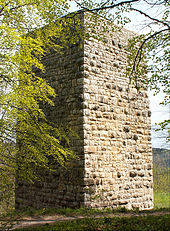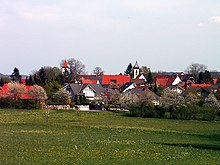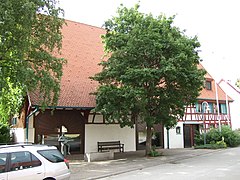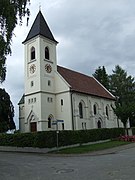Burgfelden
|
Burgfelden
City of Albstadt
|
|
|---|---|
| Coordinates: 48 ° 14 ′ 29 ″ N , 8 ° 55 ′ 56 ″ E | |
| Height : | 912 m above sea level NHN |
| Area : | 2.73 km² |
| Residents : | 306 (Jun 30, 2020) |
| Population density : | 112 inhabitants / km² |
| Incorporation : | July 1, 1971 |
| Incorporated into: | Pfeffingen |
| Postal code : | 72459 |
| Area code : | 07435 |
|
Location map of Burgfelden in the city of Albstadt
|
|
Burgfelden is the smallest district of Albstadt in the Zollernalbkreis in Baden-Württemberg on the Swabian Alb .
geography
Burgfelden is 912 m above sea level. NHN on a plateau, which the Schalksburg is in front of. From the Schalksburg you can see the Eyach valley as a deep cut . The Böllat ( 922 m above sea level ) also belongs to the same plateau , a protrusion that slopes steeply on three sides and offers an impressive view of the surrounding area. Also the high plateau of the neighboring Heersberg , at 965 m above sea level. NHN, the highest point in Burgfelden, is connected to the Burgfeldens plateau via a 60 m wide connection.
history

Burgfelden was first mentioned as Burchveld in 1064 . The village probably emerged from an ancient noble residence from the 7th century. The first traces of settlement date from the Bronze and Latène Ages . In the Schalksburg area, fragments were found from the Middle Bronze Age, with finds also from the Urnfield Age (late Bronze Age), the Hallstatt and Latène Ages ( Iron Age ) and the Roman Age .
On July 1, 1971, the municipality of Burgfelden was incorporated into the neighboring municipality of Pfeffingen. On January 1, 1975, Pfeffingen and Burgfelden became part of the newly founded large district town of Albstadt.
Schalksburg
In the course of a succession division, Burgfelden fell together with Balingen , Pfeffingen and Laufen an der Eyach in 1288 under the rule of the Schalksburg, where a branch line of the Hohenzollern ruled until 1403. In 1403 the rule of Schalksburg with the city of Balingen and 17 other localities, including Burgfelden by Count Friedrich V von Zollern-Schalksburg after the death of his only son for 28,000 guilders to Count Eberhard III. († 1417) sold by Württemberg . This transfer of rule to the Württemberg people is handed down in the Hirschguldensage recorded by Gustav Schwab and Wilhelm Hauff .
Administrative affiliation
Burgfelden was assigned to the Office or Oberamt Balingen . Thus, since 1806, Burgfelden had been part of the newly established Kingdom of Württemberg , from which the national state of the same name emerged in 1919 . In 1934 Burgfelden came to the district and in 1938 to the district of Balingen .
St. Michaels Church
Parts of the foundation walls of the first, late Merovingian building of the small St. Michael's Church probably date from around 700. Investigations on the bones from a double grave under the apse showed that the first burial complex was probably in the first half, the second burial likely took place in the second half of the 7th century. The church that is preserved today dates from the 11th century. St. Michael is known for its tower and the Romanesque wall paintings from 1070/1080, which are considered important examples of monumental early Romanesque. The large-scale depiction of the Last Judgment image with multiple depictions of the apocalyptically significant archangel and the return of Christ to judgment on the east wall of St. Michael's Chapel should be emphasized . Parallels to St. George's Church (Reichenau-Oberzell) on the island of Reichenau show influences or origins from the Reichenau school. The parish of St. Michael in 1275 included the castle chapel on the Schalksburg and the churches in Pfeffingen, Zillhausen, Ufhofen, Wannental, Laufen and Streichen. After the Reformation , St. Michael was a Protestant parish church, but the parish seat was moved to Pfeffingen in 1575. The wall paintings were discovered in 1892 when the church was about to be demolished for a new building. In 1896 a new church was finally built elsewhere.
Population development
With 336 inhabitants (as of June 2014), Burgfelden is the smallest district of Albstadt. In 1477 only three houses and the church were on record in Burgfelden. In 1892 the church was supposed to be torn down because it became too small for the rapidly growing population. In 1820 there were 167 inhabitants, in 1871 there were 236 inhabitants. The Baden-Württemberg Ministry of the Interior reported a resident population of 215 on June 30, 1971.
politics
mayor
see: List of Mayors of Albstadt
Mayor
- 1971–1984: Hermann Schatz
- 1984–1996: Hans-Friedrich Wissmann
- 1996–1997: Peter Schopfer
- 1998–2002: Thomas Haas (acting)
- 2002–2009: Marina wing
- since 2009: Hubert Reinauer
coat of arms
The blazon of the coat of arms of Burgfelden shows in black and silver (the colors of the Hohenzollern ), a shield divided in pewter cut obliquely to the left, which symbolizes the castle complex and above a shaking silver kestrel . The coat of arms was awarded to the municipality on May 25, 1950.
literature
- Friedrich Wissmann: At the Eyach spring. A home book of Pfeffingen and Burgfelden . Pfeffingen 1959.
- Georg Scheja: St. Michael in Burgfelden ( large architectural monuments , issue 177). 2nd edition, Munich / Berlin 1981.
- Michaelskirche Burgfelden . With contributions by D. Jakobs, A. Kottmann, HF Reichwald, E. Schmidt and P. Volkmer. Published by the Baden-Württemberg State Monuments Office. Beuroner Kunstverlag Josef Fink: Beuron 2004, 84 pages, 83 illustrations, ISBN 3-89870-196-4 .
- Ludwig Herter: From Burgfeld's hardest days. The years 1945-1950. Burgfelden 2009.
Web links
- District information on the website of the city of Albstadt
Individual evidence
- ^ Federal Statistical Office (ed.): Historical municipality directory for the Federal Republic of Germany. Name, border and key number changes in municipalities, counties and administrative districts from May 27, 1970 to December 31, 1982 . W. Kohlhammer, Stuttgart / Mainz 1983, ISBN 3-17-003263-1 , p. 524 and 540 .
- ↑ Federal Statistical Office: Landkreis Balingen, Die Stadt- und Landkreise Baden-Württemberg in words and numbers Issue 63 , page 29 (pdf)








